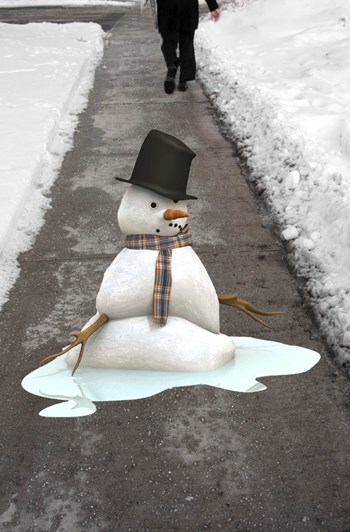
As any good co-op or condo building administrator knows—either through common sense or painful experience—failing to clean up snow or ice promptly can result in injuries, acrimony, and expensive lawsuits. Any one of those is reason enough to get serious about snow and ice control around your building, but in the current economic climate, the threat of massive legal bills is very real, and very scary. Litigation has become far more prevalent than it used to be, and insurance companies don't have the same protection that they used to have under state law. As a result, many are passing expenses and legal costs on to current clients.
So what’s a conscientious board to do when the snow flies and the sidewalk outside the building or complex is covered in a sheet of ice? Bone up, primarily. It’s your job—and knowing both what the law has to say about your responsibilities as a board as well as what products and technologies are out there to help you with you task are important pieces of the puzzle for multifamily communities.
It’s the Law
In New York, liability for a slip-and-fall accident can fall either on the property upon which the accident happened, or on the city itself—but it's usually the former. According to the legal blog www.avvo.com, “It is well established that the City of New York will not be held liable for accidents resulting from snow or ice on its sidewalks unless a reasonable time has elapsed between the end of the storm giving rise to the icy condition and the occurrence of the accident. Cooke v. City of New York, 300 A.D.2d 338, 751 N.Y.S.2d 536 (2nd Dept. 2002). However, where the city's snow-removal efforts create the icy condition or exacerbate a natural hazard created by the storm, the city may be found liable even when a storm is still in progress. It must be remembered that the city...is not always responsible for the removal of snow and ice from the public sidewalks. Under certain situations it is the duty of the abutting property owner. See, Administrative Code of the City of New York § 7-210.
That last bit regarding 'the duty of the property owner' should never be far from any manager or board's mind as the weather forecasts call for icy rain, slush, and snow in the five boroughs, says Jon Kolbrener, an attorney and partner with the Manhattan-based law firm Braverman & Associates.
“What constitutes ‘reasonable time’ depends on numerous factors, including but not limited to the severity of the storm, the amount of precipitation involved, the amount of accumulation, the temperature, and winds causing drifting,” explains Kolbrener. “The City Administrative Code provides that snow must be removed within four hours of the time it stops falling—excluding the hours between 9 p.m. and 7 a.m. The Code also provides that snow and ice that are frozen so hard they cannot be removed are to be treated with ashes, sand, sawdust or some similar material until it is possible to thoroughly clean them.”
Salt of the Earth
So you know that you need to clear the slippery stuff off your property—but exactly what kind of snow and ice removal products are best for your particular community? Choosing the cold weather weapon of choice can be complicated.While most co-ops and condos remain loyal users of basic salt blends for melting ice at entrances and in parking areas, ice-melt products have come a long way in recent years; there are well over 100 such products available now, many of which are variations on the salt theme, customized for different surfaces and weather conditions.
According to manufacturers, not all ice melts are alike. By mixing the chemical blend, makers can offer products to vary melting temperatures. Consult the manufacturers’ websites or your product dealer to learn which of them works best in your circumstances. Also, be aware that simply claiming that an ice-melt product is 'green' doesn't necessarily make it so. There aren’t many trade regulations on these products, so the Federal Trade Commission has created updated Green Guides to help both manufacturers and users. According to the FTC, when comparing ice-melt products, look for substantiated claims, such as third-party guarantees, rather than possibly deceptive product labeling. You can find more information at the EPA’s Designs for the Environment website: www.epa.gov/dfe/pubs/projects/formulat/formpart.htm#44,
Crunching the Numbers
Winter weather in this part of the country can be unpredictable, which can make budgeting for snow and ice tough. The prospect of paying for professionals to deal with mountains of snow that might not actually fall may tempt boards and property managers to simply have their super or handyman handle it if it happens—but boards are wise to remember the cost of lawsuits. Paying for plowing and/or sidewalk treatment can burden the budget in a tough winter, but expensive or not, it’s not optional—so good planning is vital. At many locations, the plowing contractor also serves as the company providing snow-melt service.
Some boards in the outer boroughs where there are more walkways and service roads to keep clear opt for protection in advance, while others take their chances. “Some associations will sign an all-inclusive agreement with a vendor,” says one property manager. “I’ve got a number that have a contractor they like working with, and they’ll be given the option for what I call a la carte service: you pay as you go.”
In other situations, they may have taken the more risky option of paying a pre-set amount, and ice removal becomes a single-priced expenditure for the year. “A lot of property managers like doing that because it helps with budgeting,” the manager continues. “If the annual contract is $15,000, they may pay $3,000 per month over five months—no matter whether it snows or doesn’t, that’s what you pay.”
According to several long-range forecasts, New York City may be bracing for above-average snowfall during the 2012-13 winter season.
High-Tech Alternatives
Savvy managers take steps to protect surfaces against any type of snow/ice or water damage: replaceable mats against tracked-in materials, extra sealing of floors before winter. But there is another option—one that is better accomplished during the construction phase: radiant heat. Because of its cost, this type of system may also be done when sidewalks are being replaced or otherwise changed.
One advantage of using built-in radiant heat systems for snow and ice control is that they can keep concrete driveways and exterior surfaces stay safer. These systems also eliminate the time and labor of using a contractor or in-house maintenance staff to plow and shovel paved surfaces and other access areas. No corrosive de-icers or chemical applications are required, thus preserving the life of the underlying pavement. And the snow melting system can be designed to shut off when the snow is cleared and the precipitation ends.
"It's beneficial mostly because of the safety aspect—especially on the stairs, which is a critical area for snowmelt and a hard area to keep clear of ice," says Gary Fries, a technical writer at Wirsbo in Apple Valley, Minn., which manufactures snow- and ice-melting systems. "Then there's the convenience. When there is salt and chemicals on the surface, people are going to drag that into the building and wear on their rugs and floor coverings."
Snow and ice melt products like residential mats with special heating coils are also produced by a Paterson, New Jersey company called HeatTrak. As a teenager, Hillel Glazer invented a crude prototype of a snow-melt mat using a heating pad, duct tape and an old doormat. Today, HeatTrak’s residential mats for steps and walkways, which can be interconnected via insulated cords, retail for about $50 for steps, $99 for a doormat, and $120 for walkways, respectively. Industrial mats cost upwards of a few hundred dollars to more than $1,000, depending on the size. Last year, HeatTrak introduced a wireless remote and thermostat controller. The industrial mats plug into a standard 120V or 240V outlet generating enough heat to melt snow at the rate of two inches an hour. Mats are sturdy enough to be left outside an entire winter season.
Among its customers are Sotheby’s auction house in New York City; Citi Field, which uses the mats at its delivery entrances; and the Billie Jean King Tennis Center, which placed the larger mats along the perimeter of its practice bubbles to prevent ice and snow from accumulating and damaging the structures.
Uponor is an international corporation operating radiant systems for heating and cooling in many countries, some of which have an abundance of ice and snow, like Norway, Finland and Sweden. Circulating a water or water/glycol solution through cross-linked polyethelene (PEX) tubing beneath concrete, turf, asphalt or similar surfaces, the radiant system warms ground surfaces to a temperature that will melt snow and ice on contact.
One major benefit is its usefulness on areas that are hard to plow, such as steeply graded roadways and pavers or other easy-to-damage surfaces. Equipped with sensors, the system is automated, tuned to respond to need. These systems can be deployed rapidly to clear handicap access, emergency traffic zones—even helipads. These systems, while more costly to install after a property has been completed, are becoming more of a must in luxury markets, where they can be connected to modulating-condensing (mod-con) boilers or even waste-heat sources for added efficiency.
Regardless of what choices managers make, they must in fact make one. The law is on the side of proactive, responsive associations who start planning their ice and snow-removal efforts before the first flake falls.
Hannah Fons is an associate editor at The Cooperator. Additional reporting by freelance writer Ann Connery Frantz.






Leave a Comment